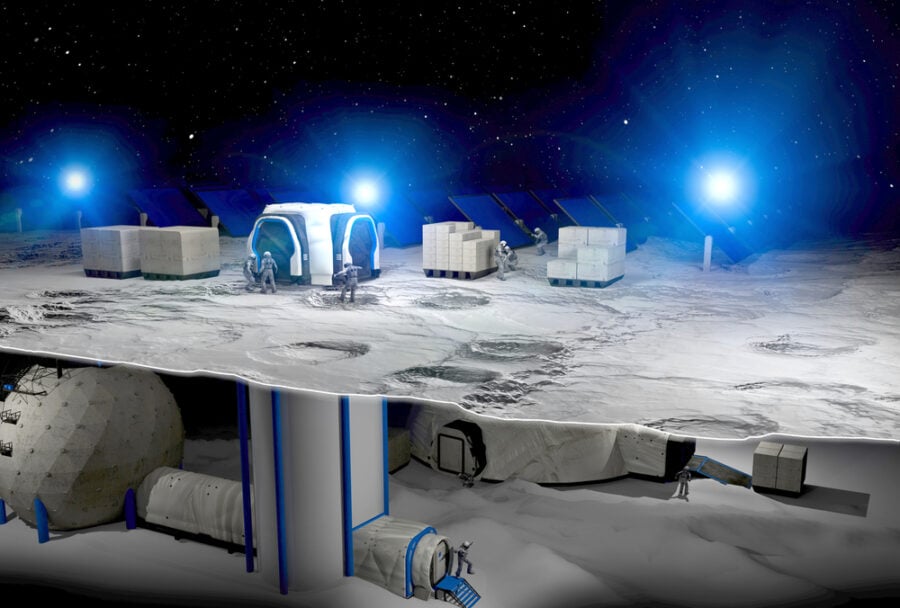One day soon, the moon will reflect not only the Sun but someone’s pool party celebrations, city lights, or high-rise buildings there.
Not the easiest of tasks. The Moon’s surface can climb to a suffocating 127 degrees Celsius during the day and drop to frigid -138 degrees Celsius at night. Not nearly as habitable as humans would like it to be to colonize the moon. But some lunar pits hover around 17degrees Celsius. Is this where some planned colonies can build, shielded from intense temperatures? Maybe, but human ingenuity never stops at such obstacles.
The first buildings on the moon
Project Olympus is a housing settlement on the moon being built by architecture studio BIG (Bjarke Ingels Group), construction firm ICON, a 3D printing leader, and non-other than NASA.
NASA has plans to explore life on the moon and as part of its Artemis program, it aims to send the first woman and the next man to the moon by 2024.
The goal of Project Olympus is to develop infrastructure for life on the moon. What’s unique about the project is the use of 3D printing technology sourced from building materials already available on the moon, making it financially feasible.
The building and architectural teams are simulating the moon’s surface in terms of atmospheric pressure and solar radiation on Earth to create an initial 3D printable construction.
In 2022, NASA named additional partners who will join BIG and ICON in realizing this project: Blue Origin and SpaceX.

Moon’s 3D printing efforts
Hong Kong researchers are trying to produce a lunar soil simulant on Earth and use it to 3D print bricks that would enable modular construction projects on the moon.
The project supports China’s Chang’e 8 mission, which aims to set up a lunar research station.
Chinese Chang’e 5 lunar mission brought 1.7kg (3.7lbs) of rocks and dust back to Earth in 2020 and the composition of these is helping scientists duplicate lunar soil.
The Hong Kong team is looking at two promising strategies for construction on the moon.
The first one is a process known as plasma sintering, which makes use of lunar plasma, a type of ionized gas, to build and shape bricks or structural elements from lunar soil.
The other way is 3D printing using the lunar regolith on the moon, a challenging task due to lack of water on the moon’s surface which impacts how the 3D printed structures harden.
Japan’s gravity structure “The Glass”
The recently unveiled 1,300-foot-tall rotating Japanese structure called “The Glass” is designed to rotate every 20 seconds using centrifugal force to achieve “normal gravity.”
The idea is to create “artificial gravity facilities” that essentially simulate living conditions of Earth and protect against the harmful effects of low gravity on human health which can cause bone loss, back pain, and kidney stones.
Plans to build the massive structure will take close to 100 years, way beyond most people’s lifetime, although a simplified version of “The Glass” could be on the moon by 2050.
The team aims to build a “Lunar Glass” for the moon and one for Mars called “Mars Glass”.
“The Glass” facilities include plans to ‘plant’ forests and waterfronts to mimic earth’s biodiversity, along with building a transportation system called the “Hexagon Space Track System,” and an interplanetary self-generating gravity space train that travels between Earth, the moon, and Mars.

China and Russia’s moon base
On March 9, 2021, the China National Space Administration (CNSA) announced coordinated plans with Russia’s State Space Corporation ROSCOSMOS for the building of the International Lunar Research Station on the moon.
The said Station is a comprehensive scientific experiment base built on the lunar surface and/or in lunar orbit that will engage in lunar exploration and utilization, and lunar-based observation, while facilitating cooperation between all interested countries and international partners aimed at using outer space for peaceful purposes.
It is alleged that the two countries want their moon base built by 2030.








